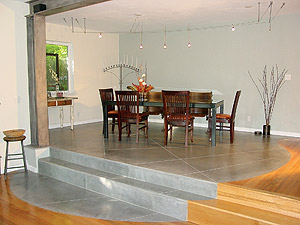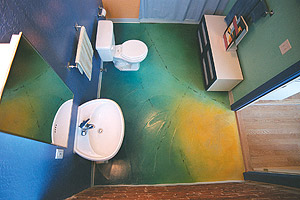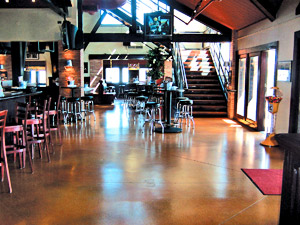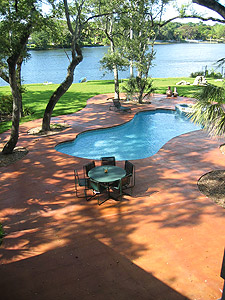 |
Acid-stained floor |
...continued from previous page
Color it Concrete
Acid stains: Paint and concrete go together like oil and water. And not only does paint bond poorly to concrete surfaces, it also obscures the natural imperfections and variations of the substrate that are a key part of concrete's aesthetic appeal.
by David Thompson
Like acid stains, concrete dyes are translucent. But unlike acid stains, they don’t react chemically with the concrete and don’t offer variegation.
Instead they offer predictability.
“What you see going down is the color it will be when all is said and done,” says Mike Miller, managing principal of The Concretist Inc., and one of the pioneers of decorative concrete. “You can almost think about dyes like lighting in a theater, where you’ve got lights with colored filters over them. If you shift to an orange filter, everything on stage looks orange. That’s kind of what happens with a dye.”
Dyes can be used on their own or in conjunction with acid stains. They come in a far wider range of colors than acid stains do, and they can be mixed like paint to create new colors. They’re sometimes used to touch up areas of an acid-staining job where the chemical reaction failed to occur. They can also be used to shift the entire color of an acid stain when the customer isn’t happy with the initial results.
Both water-based and solvent-based dyes are available.
The water-based variety offers a pastel, watercolor look, which can work nicely when layers of color are called for.
Solvent-based dyes produce bold colors. Solvents quickly carry molecules of dye into the concrete and then rapidly evaporate, leaving deeply saturated hues.
Both types of dyes can be applied in the same ways acid stains can be applied: with sprayers, brushes, rollers, sponges, etc. Concrete must be thoroughly cleaned and absolutely dry before applying dyes. The more porous a floor, the better it will accept dye. Hard-troweled or other closed surfaces might need to be opened up with an acid etch before dyeing.
One thing to bear in mind about solvent-based dyes: they are highly flammable and have caused serious injuries.
 |
 |
| Top: Floor create with dyes; Bottom: Acid-stained floor |
Like dyes, acrylic-based stains offer far more color choices than acid stains. And also like dyes, they can be used in combination with acid stains or on their own.
There are two basic types of acrylic-based stains. One produces opaque, membrane-forming coatings that act like sealers. These are a popular choice for driveways, garage floors and anyplace else that a solid, uniform color is desired. They are, essentially, a concrete paint, and therefore aren’t widely used by hard-core, variegation-loving concrete artisans. The other type of acrylic-based stain is translucent and penetrating, rather than membrane forming, and produces results similar to concrete dye, allowing the natural beauty of the concrete to show through. The majority of acrylics on the market are water-based, though a few manufacturers offer solvent-based stains. Unlike acid stains, acrylics don’t need to be neutralized and they don’t leave a residue that needs to be cleaned. They are safer and more user-friendly than acid stains, and some concrete artisans use them exclusively. Acrylic-based stains don’t typically provide the variegation of acid stains, although mottling can be achieved by building colors or layers on top of each other. And at least one manufacturer, Smith Paint Products, has devised an acrylic stain that mimics the variegation of an acid stain by exploiting the specific gravity of the colorants and differences in the concrete porosity of concrete to achieve mottling, according to Chuck Brunner Sr., president of the company. Brunner says the final look is similar to that of an acid stain, but it’s more predictable. “It’s ‘consistently inconsistent’ compared to acid stains, which are ‘inconsistently inconsistent,’” he says.
 |
Acid stains were the coloring agent for this outdoor patio. |
Acrylics tend to be more susceptible to fading and wear than acid stains. UV resistance varies from product to product, though even those that aren’t UV resistant can be protected with a UV enhanced sealer. Some concrete professionals reserve the term “acrylic stain” strictly for the opaque variety, putting the translucent acrylic-based stains into a separate category entirely. “We call them water-based penetrating stains,” says Scofield’s Thome, “although they do have a small amount of acrylic in them, which enables the pigment to be carried to the concrete.” Whatever type of coloring system you chose to use, be it acid stains, acrylic stains or dyes, decorative concrete should always be sealed to protect the surface and simplify maintenance. 
|

